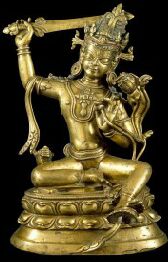
Terresa M. Fagan |
 |
 |
 |
| HOME |
| Resources |
| Lesson 4 Finding Global Connections Through Art |
| Lesson 7 Sacred Circles |
LESSON FIVE- Applying Social Criticism to Works of Art
OBJECTIVE: Students will learn to identify the dynamic societal domains in which a work of art is created.See Resources page for various links to make selections.
Definitions
Society - two or more individuals sharing something(s) in common.
Culture - thoughts, beliefs, actions, rituals, etc. of a society.
Economy - anything of value that is exchanged.
Government - the rules, regulations, and powers of enforcement in a society.
Expect spend at least three to four days on this lesson.
*Day one - Teacher explains and models lesson. Students research and find a work of art with historical details from the from the Himalayan region.
*Day two - Students will research the societal domains in which the work was created:
Culture, Economy, Government
*Day three - Students will write a formal essay discussing the three dimensions of the society where their art selections were created.
*Day four - Students present their selections and societal discussion to the class.